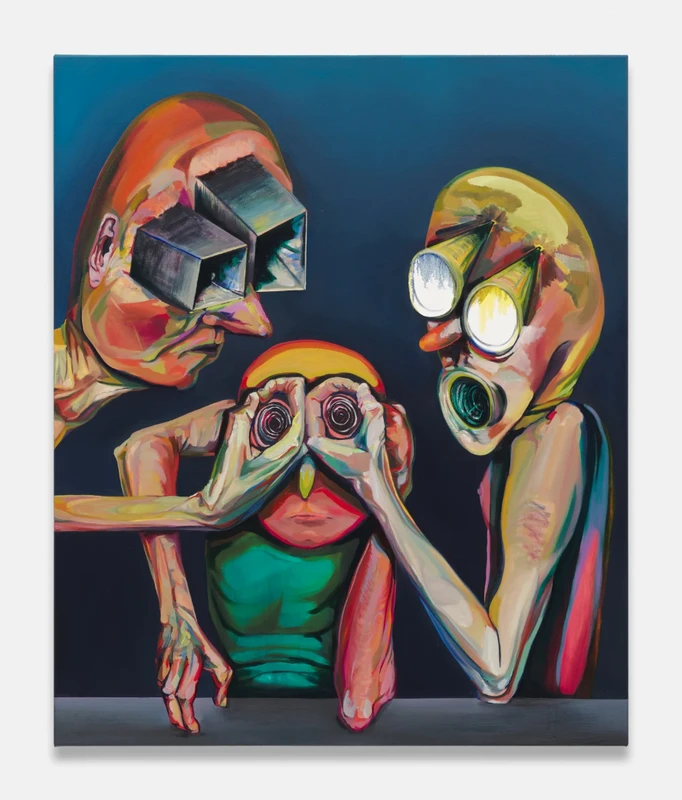Emma Cousin: Tunnel Vision
19 Jan-24 Feb 2024
PV 18 Jan 2024, 6-8pm


“We don’t see things as they are, we see them as we are” - Anaïs Nin
In her 1961 autobiographical novel ‘Seduction of the Minotaur’ Anaïs Nin writes about two characters who react very differently on seeing the River Seine:
“Lillian was bewildered by the enormous discrepancy which existed between Jay’s models and what he painted. Together they would walk along the same Seine river, she would see it silky grey, sinuous and glittering, he would draw it opaque with fermented mud, and a shoal of wine bottle corks and weeds caught in the stagnant edges.”
That Jay is an artist is perhaps not surprising for the trope of the artist as having a very particular, singular vision is a common one, satirised in the comedic creation of the sketch show ‘The Fast Show’ in the figure of the amateur painter Johnny Nice. Johnny is a happy, pleasant-mannered amateur artist who enjoys painting landscapes with his wife until the word ‘black’ is mentioned at which point he is plunged into a wild existential despair, spiralling into doom and crises. The sketch hinges on the same joke over again. Despite the pretence at conviviality and collegiality, the artist is easily revealed having tunnel vision. Johnny only has one way of picturing the world, but perhaps it is arguable that one of the roles of an artist is to show us the way that we all subconsciously interpret what we see in front of us; myopically.
A number of the figures in Emma Cousin’s new series of works seem to have just stumbled across the joys and pitfalls of tunnel vision. In ‘Gnawsea’ (2022) we see three figures whose appearances and poses will be familiar to viewers who know Cousin’s previous works. Yet these figures seem to have discovered something new, a form of looking that opens up unimagined vistas, a ‘tunnel vision’ that is new and startling. The figure on the left is transfixed by a pair of tunnels that look like binoculars, the one of the right looks back at the viewer with eyes that have been transformed into what look like tube tunnels boring into their inner being. The figure at the bottom of the painting is sightless, lacking the new abilities of the other two. A similar dynamic is at work in ‘UTR’ (2022-23) where two figures seem to have developed tunnel projectiles from their eyes, and are either helping or hindering a third at the bottom whose relationship with this new ability seems more ambiguous.
The link between tunnel vision and the act of visual creativity is underscored by Cousin’s own account of being in part inspired by the “violent comedy” of ‘Road Runner’ the Looney Tunes Cartoon. In particular Cousin notes the attempted stunt played by Wile E. Coyote on Road Runner in the episode ‘Tunnel Vision’ where Coyote paints a trompe l’oeil tunnel onto a rock anticipating Road Runner will crash into. Road Runner, of course, ploughs straights through it. In a way Road Runner is suffering from tunnel vision in more than one sense; he is both entirely focused on the tunnel seemingly ahead of him but also on the chase that it ignored the artifice, or indeed the rock face.
The figures in Cousin’s paintings are not only experiencing tunnel vision, they often manifest it within their own bodies. Mouths open up to reveal tunnels, eyes become tunnels boring into other’s heads, noses extend out to end with a tunnel opening. Cousin writes that during her pregnancy, she became more aware of the body being a series of tunnels, which were only usually noted when something went wrong such as carpal tunnel syndrome. Picturing the body as a series of voids, caverns, connecting tunnels and passageways is apparent in a work such as ‘Tsog’ (2023) where the top of the figure’s head on the right hand of the painting opens up to reveal what looks like a cave. Perspective switches from exterior to interior, with the ‘cave’ seemingly extending far beyond where the back of the figure’s head would be.
A similar device is at work in ‘Massacio and Coyote Collude’ (2023), where the nod in the title towards the early Renaissance painter Massacio is telling; the artist’s work ‘The Holy Trinity’ is considered the earliest surviving work to use systematic linear perspective and a vanishing point. the archway around Christ and the barrel vault behind become a tunnel. Vasari described this part of the work: “a barrel vault drawn in perspective, and divided into squares with rosettes that diminish and are foreshortened so well that there seems to be a hole in the wall.” Coyote then, perhaps later was paying unwitting homage to Massacio.
“We don’t see things as they are; we see things as we are.” Perhaps it is us, the viewer, as a series of tunnels and passageways each disappearing into the darkness that unconsciously insist on seeing those vanishing points in paintings, those trompe l’oeil moments that we fall for. We externalise our way of being onto these canvases, onto the figures in front of us, bringing the structures of our internal self, which paradoxically we never really get to see, into the interpretation of the surface of a canvas. We peer through our own tunnel-shaped binoculars to fit the world together, assuming that the way that we see it must be the way everyone else does, correcting their mistakes. Looking back again at the figures in ‘UTR’ it seems more like that the two figure flanking the central figure are not helping at all; instead their hands seem to be in the process of forcefully turning that third figure’s ‘tunnel vision’ screwing it back in the direction they think it should be in; ultimately they can only see things as they are.